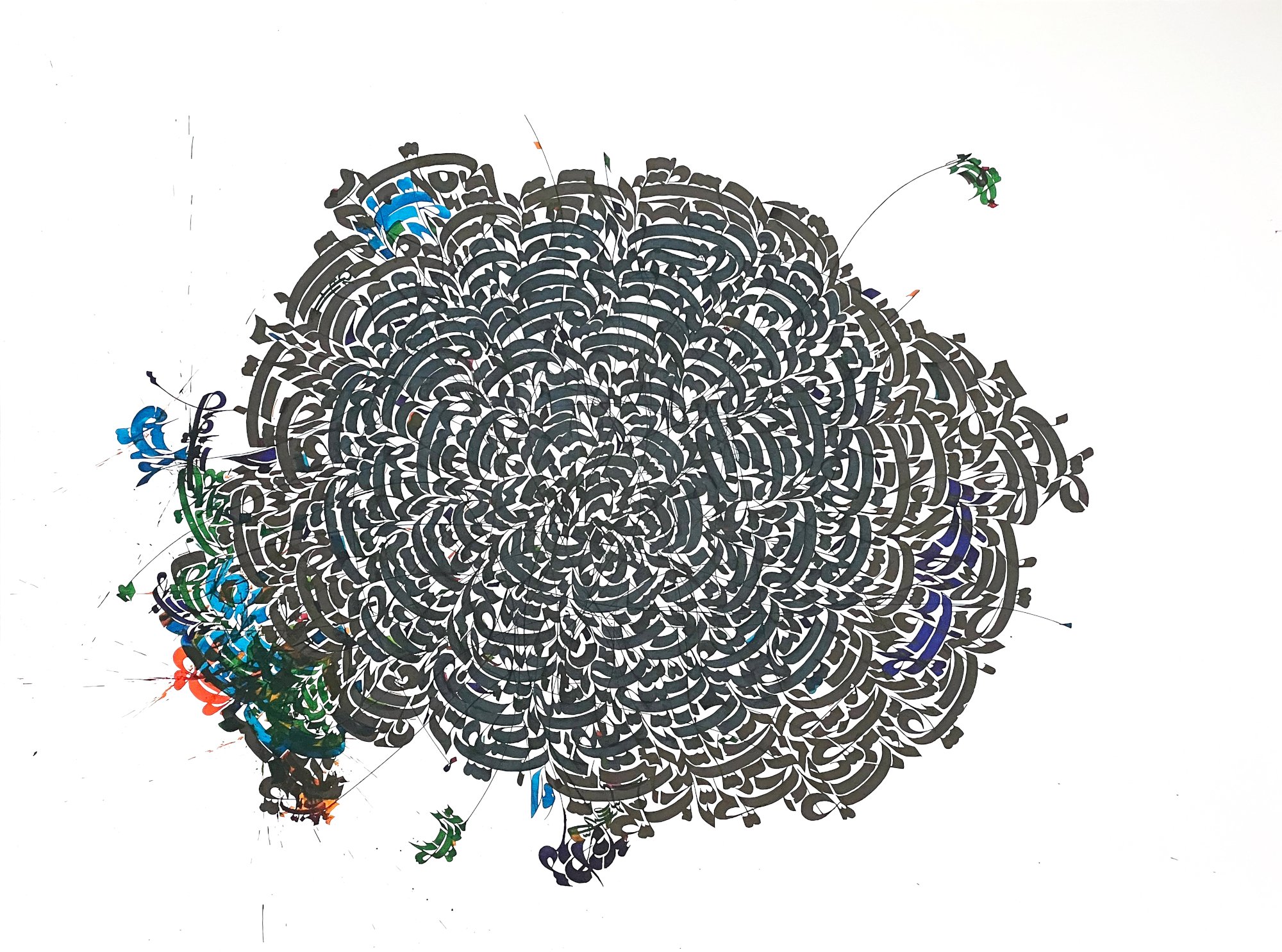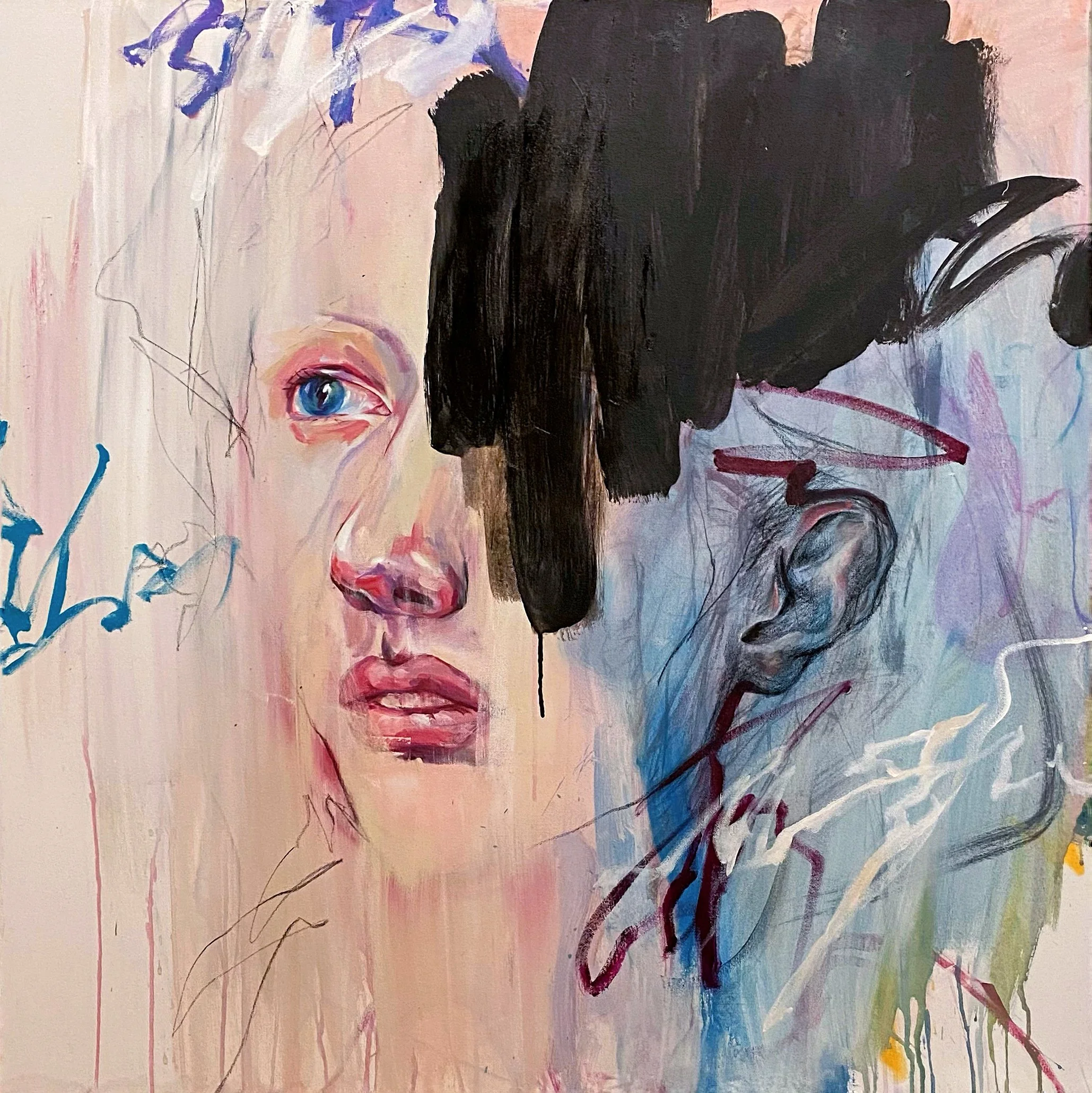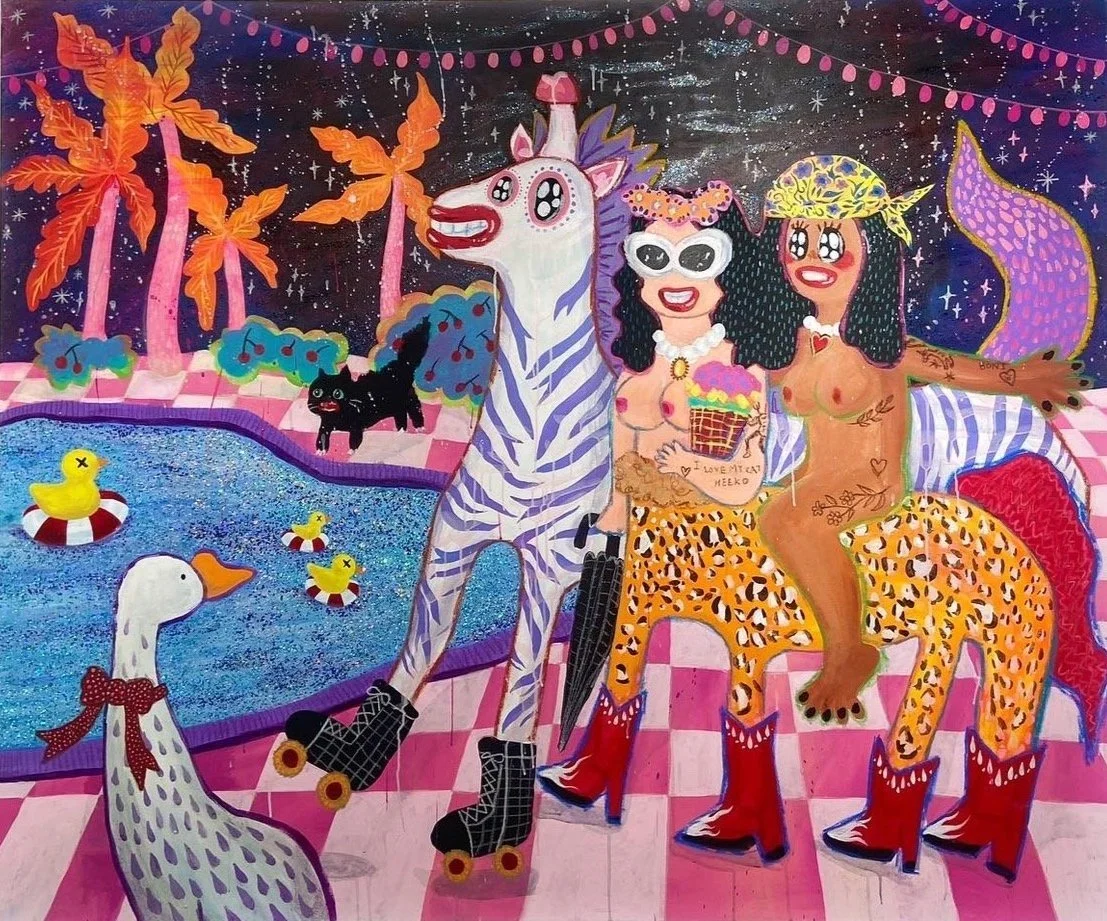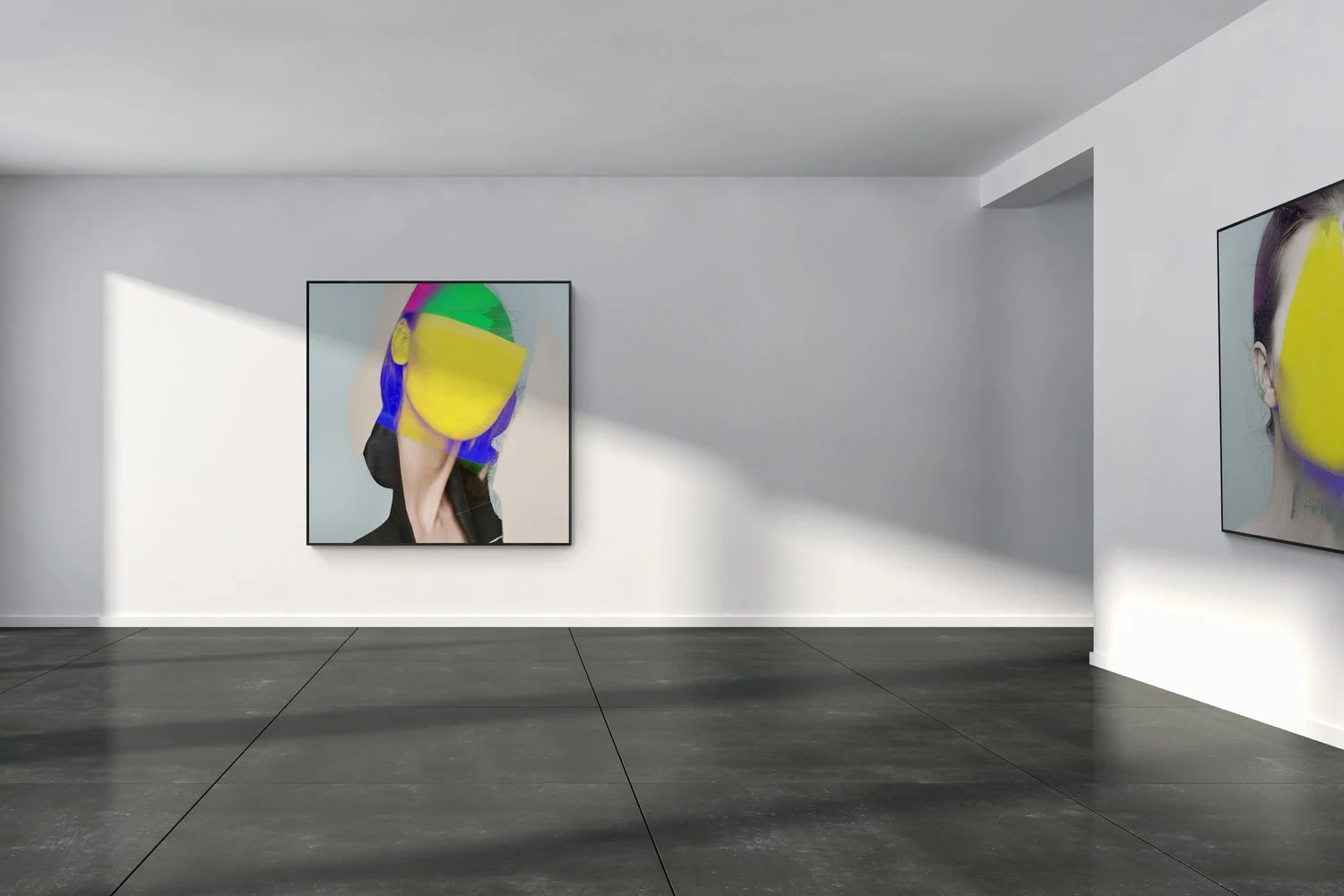10 Questions with Alfred Stoll
Alfred Stoll was born on 17/07/1993 to a family of ethnic Germans in Kazakhstan. Soon after the Soviet Union collapsed, his family moved to Russia, first to Siberia and then to the South of Russia, to a small town in the Caspian lowland. There he went to school and got his first art education. He received his architecture degree from Astrakhan State University of Architecture and Civil Engineering, moving to St. Petersburg after finishing his studies. A year later, he and his family decided to move to Germany through a program supporting repatriates. Since 2017 Alfred Stoll has lived in Bavaria, where he makes his art and participates in integration programs for immigrants.
Alfred Stoll Portrait
ARTIST STATEMENT
In the art community and his works, Alfred Stoll is interested in topics such as the influence of digital approaches and techniques on contemporary art and on the artist, determining the artistic value and importance of digital art today, defining the artist's role in the creation of digital art in the future and metamodernism in art.
In his works, he doesn't use the digital environment as analog instruments, such as a brush and a canvas. Instead, the process of creation lies in a combination of techniques: invert colors, double exposure, distortion, multiple overlay, stylization, motion and AR, 3D modeling, as well as digital drawing and painting. Differing greatly from the usual artistic techniques, not having a basic methodology of use and implementation, they require a different approach and often resemble an alchemical experiment. His digital laboratory fits into his smartphone and tablet, always with him, easy to use, and doesn't require anything besides his interest in creative experimentation.
The main art direction Alfred Stoll creates in is metamodernism. The idea of new sincerity, tenderness, sensuality, creative freedom, and post irony resonate with him and inspire him. His works are a condensation of his personal experience and a compilation of the global stream of information through the reimagining of meta-narratives due to mental oscillation between two chosen polarities, as well as the search of his own and social boundaries.
INTERVIEW
You have an interesting background, you have lived in different places and had many experiences despite your young age. How did art help you over the years?
Art has always been a part of my life, and it always comes to me in different ways, as if it's a path trying to show me all the beauty of this enormous world. And behind every new door, I get new opportunities to open even more entries in this labyrinth of life. For many years I've been following this path, sometimes deviating or taking a break from it. But it's pulling me so strongly that I continue to hit this road again and again, and it's radically changing my life every time. Yet, I am always welcoming of this change because the path has never let me down. All of this can be considered a calling. You don't choose but rather follow something bigger, something that cannot be described verbally. The only and most important thing I understand is that I'm here to create beauty in all its manifestations, glorify it and bring its allure closer to people. So I hope this path will take me even further and open more new doors on my way.
What is your artistic background? And when did you first realize you wanted to be an artist?
I have a bachelor's degree in architecture, and in addition to working in an architectural bureau, I managed to gain experience as an interior designer and 3D designer in print production.
The conscious decision to become an artist came to me after moving from Russia to Germany, where I felt at home for the first time. If I were asked where my homeland is, I would answer in Bavaria despite living here for only four years. I feel some kind of power here. It nourishes and inspires me. Here I stopped considering myself weird, and when in 2020 I openly declared that I was an artist and would move in this direction, it felt like this was something right, something the path of art had been leading me to all this time. I am grateful for this opportunity, all the people and situations in my life that influenced me.
In your work, you mix traditional influences, like Caravaggio and Michelangelo, with pop culture and pop art. How did you come up with this concept?
Mixing the traditional and the modern, the boundaries blur and sometimes disappear, which contributes to the popularization of art among the masses and gives a fresh air of air to old works of art. For me, there are no categories of elite or vulgar art. The truth is always somewhere in between. Many of my works are an aesthetic experiment, implying mixing the generally accepted "high" and "low" forms into one whole, where I hope the snobbery, seriousness, and high importance of overvalued works of art decreases and the value of undervalued ones increases. I would call it a metamodern balance, where there is neither black nor white, but only fluctuations between them.
What are the main themes behind your work? And what does your art aim to say to the viewers?
My work is often based on my personal experience and processing a large amount of information that comes in an endless stream from everywhere. That is why my work is usually created from many visual fragments and images. There are often images of classical works of art in my works, which I studied for quite a long time at the university, places, events, and people I met along the way and found a response in my works. And it's also about gratitude for being able to see, know and emotionally experience what is happening to me. The active popularization of art in society has led to the emergence of a large number of new artists working both in the classical genre and with new experimental approaches and techniques, which I am certainly very happy about. But at the same time, skepticism and snobbery have increased both in the artistic environment and among the audience. Interest in art has grown the same way the question "is this art?" has. In my works, I strive to exclude the element of seriousness, both in the topic and in the technique of creation, using post irony, freedom of expression, from bright colors to a combination of incompatible, openness to taboo topics and rethinking metanarratives - rejection of stereotypes of the past and movement towards cultural plurality.
Teresa’s meta ecstasy, from the series Mosaic, 100x150 cm, 2021 © Alfred Stoll
Space, from the series Mosaic, 90x120 cm, 2021 © Alfred Stoll
What artists influence or inspire your work most? Or, more in general, where do you get your inspiration from?
My favorite artist is Gustav Klimt, who later turned out to be a huge influence on my work. I like to combine different textures, work with bright colors combined with gold, experiment with decorative elements and fabrics. I am very much inspired by a person as a visual sensory object to express any emotions and reactions. Perhaps that is why a female image plays an important role in my works, reflecting the full range of emotions from tender sensuality to destructive hatred. More generally, I am inspired by the people, places, situations, and knowledge that come my way. The only thing you need is to start listening to yourself, not to be afraid of your emotions and ideas, and your inner self will tell you what gives you goosebumps.
How do you create your works? What is your creative process like?
"For me, restrictions are not always negative. Restrictions can push creativity. I like restrictions." Dries van Noten
To describe my creative process, I would like to contradict this quote to some extent. Limitations and contradictions were the first things I encountered when I started my conscious career as an artist, and later they strongly influenced my creative process.
As a matter of fact, my primary art education has always been associated with academic drawing and painting. I was often criticized by teachers for uneven strokes, thick lines, or dirt on my work. After graduating from university, I had a persistent feeling that my painting was mediocre, and the thought that I would someday become an artist never arose. But at the beginning of the pandemic, I got an urgent need to create something, immerse myself in the creative process, and dissolve in the world of art. Not having much to choose from, I had a smartphone and a couple of mobile drawing applications at hand. It was a challenge - to create something beautiful using minimal funds. Armed with a smartphone and an index finger, the process started and it was no longer possible to stop it.
It all started with mixing images from free photo stocks by overlaying images, stylization, and inversion. It was an uncontrolled process of mixing everything that came to hand until interesting images and complex textures began to emerge, which were already deliberately completed with the necessary actions. It is very similar to painting, only instead of paints, I use digital trash, which I combine until something new and interesting is obtained. When creating works on a small phone screen, it is probably difficult to imagine that in the real world, they are best perceived in large formats from one meter to two meters, and mobile applications currently allow you to draw without loss of quality when printing.
The second step for me was the challenge to draw on a small phone screen, and one of the possible options was sketching simple lines with the index finger. This has its own charm, similar to one of the primitive drawings on the walls of caves. Only instead of walls, it's an endless digital canvas. Interestingly, I only consider the drawing done when I am completely satisfied and delighted with it, and the last thing I draw in my works is the same red dot that often appears in my paintings. For me, this is a kind of "assemblage point" or "finishing touch" at work.
The third stage for me was the search for new mobile applications that could expand the tools in my arsenal and experiment with various methods of transforming and distorting images and mobile animation. Plunging into the process, an alchemical laboratory opens in front of me. The outcome of experiments is never clearly defined. This is the main value of the process in which I can completely immerse myself in work and leave the real world for a while. The average amount of time needed for one piece is about 5 hours, and coming out of this state, a surge of energy comes to me, and the feeling as if I have cognized something intangible.
I perceive life as an interesting game, as a creative experiment, in which you are constantly given tasks for your development. These tasks are called opportunities, and the unfulfilled tasks given to you are called tests… tests of strength to get the opportunity again. Therefore, I learned to see opportunities even in limitations, not blindly believing the opinions of others.
Diana, from the series The New Antiquity, 80x120 cm, 2020 © Alfred Stoll
Sasha, from the series Сities and People, 80x120 cm, 2020 © Alfred Stoll
In your statement, you talk about “metamodernism.” Can you explain to our readers what it is and how it influences your work?
Metamodernism describes the processes and phenomena in culture and society from the beginning of the new millennium to the present. It was introduced in 2010 by Dutch philosophers Timotheus Vermeulen and Robin van den Acker in their essay Notes on Metamodernism. The prefix "meta-" establishes a specific understanding of the term and the current perception of the world. This Greek prefix has three meanings: alongside, between, and after. Philosophers argue that metamodernism must be viewed simultaneously and three-dimensionally: epistemologically as "alongside" postmodernism and modernism, ontologically "between" postmodernism and modernism, and historically "after" them.
Three important aspects emerge from this concept.
1. Metamodernism is not a harbinger of the decline of postmodernism, much less a negation of it. Traditional, modernist and postmodern values will coexist for a long time in the global society along with metamodern ones due to the uneven development of society and the gradual transition from one set of values to another.
2. Simultaneously relying on the basis of modernism and postmodernism and constantly rethinking them, metamodernism forms tense dialectical contradictions between them, thereby creating a conflict that contributes to the further development and combination of opposite concepts in a new quality.
3. Although historically metamodernism appears after postmodernism, it does not occupy a dominant position in all anthropological spheres. However, unlike postmodernism, which divides the world into many parts form a common whole, metamodernism perceives the world and culture as one common stream of meanings, which are parts of a common truth, where each unit is important and self-sufficient. There is no place for snobbery, elitism. There is no high and low culture in it.
Metamodernism is not a prescriptive philosophical concept but rather has a descriptive character of the current historical moment, in which dialectics has re-emerged, constantly questioning and rethinking stable and consolidated positions and metanarratives until recently.
As an artist and a contemporary, I would like to analyze two themes that excite me in the context of metamodernism.
The Shield, from the series The New Antiquity, 100x100 cm, 2020 © Alfred Stoll
Metamodern person
Metamodern is an elusive truth somewhere in the middle. Finding themselves in a dead-end of postmodern values, which can no longer satisfy the further development of culture and society, the metamodern person is trying to build a new relationship with truth and its understanding. This relationship between absolute truth, person, and reality is built thanks to joint non-confounding dialogue and co-creation - "new sensibility". And first of all, this turning inward, through self-reflection and subjective experience of truth, is revealed by a person, refracted through his individuality. At the same time, the Metamodern person recognizes that feelings and ideas that are obvious to them may not be such for another, due to which they can empathize with someone else's subjectivity without negatively differentiating themselves from another person. This allows one to consider several points of view simultaneously, perceive opposite ideas, and, as a consequence, more holistically, nonlinearly perceive the series of events and phenomena.
In addition to internal and external dialogue, to comprehend the truth, the metamodern person enters into co-creation with reality by creating "atmospheres". The atmosphere is understood as non-verbal communication with an object, based on the experience of feelings and ideas before they are comprehended in a common reality, both for the subject and for the object of perception, and has an ideal nature, since it is experienced by the very essence of the subject, which is also physically imperceptible, which contributes to the realization communicative unity with the truth.
German philosopher Gernot Boehme cites the ability of architecture to actively influence the viewer as an example of "atmosphere". "It is not the forms themselves that act on the beholder, but the atmosphere created through their combination." However, not only architecture or work of art has an individual atmosphere, but also any other perceived object.
Another important term in defining a modernist person is "new sincerity." The generation of the metamodern is characterized by contradictions that coexist without conflict with each other, thanks to which the fullness of culture is revealed to people, where it is possible, without shame and ignorance, to simultaneously perceive and love all genres of music, literature, films, etc., because in metamodern there is no high and low. Still, there is a single stream where every element is important, which allows you to experience sincere feelings, even while realizing that they may look ridiculous from the point of view of others. The attitude of the metamodern person towards mistakes softens, with the understanding that they are part of development and can be corrected by a new strategy of behavior at any time. This satisfies the primary need for safety and contributes to further development and going beyond the established norms. Oscillations between opposites explain that a person is not associated with any phenomenon and ultimately is not identified with anything. When asked to be or not to be, Metamodern Hamlet will choose the infinitely variable "or" as the Absolute inexorable truth somewhere in between.
Metamodern in art
People with the traits of a metamodern person put themselves where, first of all, they can reveal and realize their creative potential. The border between life and art is inexorably dissolving, mixing them into a single whole, making human life a work of art. The most common way to do this is through performances, the stage for which is increasingly becoming social networks. There a person can set an aesthetic context, putting his own meanings into it and creating "myths" around his own person. These performances allow both the author and the viewer to transcend the norm for a short moment and rethink the boundaries that hold them back. One of the examples is my open photo project "De mon âme à ton âme", which reveals sexuality in different forms.
Metamodern art strives for multidimensionality, considering many positions at the same time. Constantly oscillating between subjective and objective, fictional and real, past and present, virtual and real, the artist is forced to seek support in himself through the reflection of feelings, ideas, and emotions, which gives rise to a "new romanticism" in art in which the artist's authenticity and his perception of the world are of paramount importance.
New romanticism is a frank conversation between the artist and the viewer about what really worries and interests him, without fear of offending or offending someone. This is a return to lost values, a respectful rethinking of the world's cultural baggage, a reassessment of traditional views of reality with an attempt to change the rules of the game. And the main task of pragmatic romantics becomes to express the joint experience acquired at a certain time and in a certain place, conveying the structure of feelings and the atmosphere of our time, focusing on the processes and carefully observing the formation of phenomena in culture and society.
The aesthetics of the new romanticism is directed directly to subjective perception and the creation between the subject and the object of perception of the very "atmosphere" for sensory cognition of reality. Thus, as a co-author, the viewer, coming into contact with art, sensually experiences it, introducing new meanings based on his personal experience and knowledge and receives aesthetic pleasure and sensual contact, awareness of the multidimensionality of reality, and rethinking of metanarratives.
Modern artists are increasingly using fragments of the past culture, refracting their own individuality through them, thereby reflecting the present and letting a ray of light into the future. These shards are artistic styles, images, techniques, and devices from the past. And the purpose of using these fragments is to create a beautiful mosaic celebrating the beauty and excellence of what was created earlier, with gratitude and respect for the style and material. In my series "mosaic" or "new antiquity" I unconsciously adhered to this concept, randomly mixing styles, images, and techniques of the past, while trying to go beyond convention and rethink the treasures lying in the dustbin of history. Before creating something new, look around, and you will realize that you are standing on the top of a thousand-year-old mountain of fragments of culture that require faceting for a long time.
Alexanderplatz, from the series Сities and People, 80x120 cm, 2020 © Alfred Stoll
Mr. Q, from the series Сities and People, 80x120 cm, 2020 © Alfred Stoll
Saint Petersburg, from the series Сities and People, 80x120 cm, 2020 © Alfred Stoll
In your work, you use different mediums, and you also work with digital art. What do you think of NFTs? Do you think they are just a trend, or are they here to stay?
NFT is a great copyright tool for digital artists and digital asset owners. However, if you look at NFT as a commercial tool and given the quick rise in prices for them in the spring, this may just be a trend. A quick rise can mean a quick drop, which can already be observed now. I think this happened because, with a sudden high demand for digital art, the market was not ready to provide the rules of the game with a new asset, a sufficient number of marketplaces, and the democratization of the crypto market. As a result, a speculative bubble has formed on the market, inflated by interested investors, including small NFT marketplaces, promoting mainly long-known digital artists with high sales even without blockchain technology. A kind of elite club that you can become a part of only by invitation or acquaintance. However, in our time, everything speculative and elitist collapses before it can begin. The bubble burst, but the beautiful NFT tool remains. In the future, there will be gradual democratization of the crypto art market with legal regulation, which will contribute to a smooth growth for this asset or similar ones, taking into account the fact that the virtual world is increasingly spreading in the real one.
Over the past 12 months, we have witnessed a growing number of online exhibitions and live events. What do you think of the recent changes in the art world? Do you miss the art world as it was before the pandemic, or do you see more opportunity now?
Global digitalization affects all spheres, entering more and more into everyday life, and art is no exception. The real and the virtual are the same world for me, which I study with interest, and the most interesting to me happens at their junction, where it is possible to perceive reality from many positions.
Excluding one of the two, you can lose all the fullness of life, for example, with the rapidly growing number of digital art, a person who denies the virtual is soon doomed to lose understanding of the general flow, and people who go completely into the virtual lose touch with reality. Therefore, combining the real and the virtual remains important for me, to find new opportunities in this for realizing my goals and getting real pleasure from this.
And lastly, what are you working on right now? Anything exciting you would like to tell our readers?
Currently, I am working on one project dedicated to studying the concept of "democracy" in the Russian context and the current political situation in this country. I want to reveal this topic with the help of the internment of Russian citizens and migrants from Russia with different backgrounds, which will aid me in composing a voluminous picture of what is happening, as well as revealing the visual images of democracy in their understanding, creating a digital painting through the prism of my perception.
In addition, I plan to participate in a large exhibition and art residencies as tools for my further development and meeting new people, seeing places, and having experiences for inspiration. And I call on artists for joint co-creation and collaborations. This greatly contributes to the development of artists and the transformation of culture and society. Together we are strong! Thank you!
In the process of writing this interview, I received a proposal for a personal exhibition at the Rote Galerie in the city of Nuremberg, which I am very happy about, and I invite everyone on August 1 at 18:00 to the opening of the exhibition to get acquainted with me and my work in person. I'm looking forward to meeting you all!



























